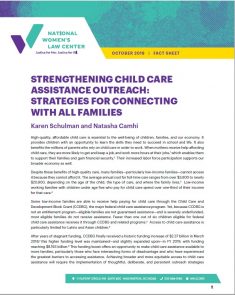Abortion rights, women of color, and LGBTQIA+ people are under attack. Pledge to join us in fighting for gender justice.
High-quality child care is essential to the well-being of children, families, and our economy. Yet many families—particularly low-income families—cannot access child care because they cannot afford it. Some low-income families are able to receive help paying for child care through the Child Care and Development Block Grant (CCDBG), the major federal child care assistance program. After years of stagnant funding, CCDBG finally received a historic funding increase of $2.37 billion in March 2018, and this higher funding level was maintained—and slightly expanded upon—in FY 2019. This funding boost offers an opportunity to make child care assistance available to more families, particularly those who face intersecting forms of disadvantage and who have experienced the greatest barriers to accessing assistance.
Achieving broader and more equitable access to child care assistance will require the implementation of thoughtful, deliberate, and persistent outreach strategies to help families learn about the availability of assistance programs and encourage them to enroll in these programs. It will also require efforts to strengthen the child care assistance programs themselves, so that families see clear benefits of enrolling. Finally, it will require increased federal and state investments in child care assistance programs so that they are available to all eligible families who want assistance.
Federal and state policymakers, leadership and staff of state and local agencies, community leaders, and child care advocates can ensure effective outreach to families for child care assistance programs through several key steps:
- Leverage existing networks, relationships, and community leaders.
- Develop outreach and enrollment infrastructure that reflects and responds to families’ needs.
- Build relationships between caseworkers and the families they serve.
- Make child care assistance programs work for all families.

